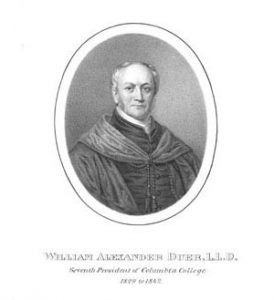Students sent home mid-semester; online classes; non-essential staff and faculty working remotely; the cancellation of commencement. As the Columbia community continues to deal with the ever evolving COVID-19 health crisis, you may be wondering how Columbia responded to previous pandemics and health crises in New York City. There are two interesting tales to be told.
In the summer months of 1832, cholera overtook New York City. The first case in NYC was reported on June 24, 1832 and, due to a lack of understanding of how the disease was transmitted, was primarily blamed on recent immigrants – in whose cramped neighborhoods the outbreaks seemed to cluster. Fear of the disease became so prevalent that many thousands of people actually fled the city. Out of a population of about 250,000 people, it is believed that at least 100,000 left the city during the summer of 1832. By the end of the summer, the epidemic seemed to be over, but more than 3,000 New Yorkers had died.
There were only 127 matriculated students at Columbia in 1832 – 28 of them seniors, but the epidemic directly impacted their activities. The last session of instruction for the academic year ended abruptly and the public commencement exercises, which would have taken place on the second Tuesday in August, were cancelled. The Board of Trustees did not hold any meetings from July to September as there was no quorum available.

In an 1833 report the President of the College, William Alexander Duer, recounts:
“The celebration of the annual commencement having been prevented by the existence of the malignant disease which put a sudden termination to the last session previously to the concluding examinations of the students, except those of the Senior Class, the Degree of Bachelor of Arts was conferred on all members of that class on the recommendation of the Faculty and with the sanction of the Board, by delivering to them their respective Diplomas. The medals provided by the Statues were at the same time delivered to those members of that class to whom they had been awarded. But as, from the cause already referred to, there was no examination of the other classes, no medals were awarded and delivered in those classes.”
There is no record of any member of the Columbia community dying as a result of this epidemic.
Eight-six years later in the fall of 1918, with World War I raging in Europe, Columbia welcomed over 2000 young men from all over the city and the country to be trained on campus as soldiers to fight in the War. Just as this Student Army Training Corps (S.A.T.C.) was about to be inducted in October, the University was suddenly faced with a world-wide health crisis: the 1918 influenza pandemic. After much consideration, the importance of the army training was determined too vital to the war effort to cancel. So how did the University respond? They instituted intense hygiene protocols which proved to be incredibly important in keeping the virus in check that autumn.

When the first cases appeared in Kent Hall – which was being used as improvised barracks – sanitary conditions were found lacking and were immediately changed. This included decreasing the number of men sleeping in these barracks and increased lavatory facilities. As the Report of the University Medical Director, Dr. William H. McCastline, in 1919 stated: “…every precaution that promised to eliminate the possibility of spreading infection, was taken…. The mess hall was carefully cleaned and ventilated. The men were compelled to sleep with windows and doors wide open. Great care was taken as to the cleanliness of the men’s bodies and clothing…. Anyone found with a temperature of ninety-nine or over was immediately placed in the infirmary for observation and treatment…. We had 200 cases of influenza, 48 cases of pneumonia, with but two deaths. Our health record is among the best thus far reported in S.A.T.C. camps throughout the country.”
But it wasn’t just student soldiers who were impacted by this pandemic. Across the street at Barnard College, Virginia Gildersleeve reported:
“The difficulties and complications of the autumn were greatly increased by the influenza epidemic. Though we stopped all meetings, entertainments and other social events, we continued our regular work without a break. Many of our officers and students were ill, but fortunately there were no deaths among them…. To our college physician and trained nurse for their devoted and efficient work during this trying season we owe a debt of gratitude.” (1919 Annual Reports, p. 183)
On January 6, 1919 there was a resolution passed by the Trustees thanking Dr. William H. McCastline and Dr. George L. Meylan for “their devoted and remarkably successful efforts for the care and protection of students of the S.A.T.C. [Student Army Training Corps] in the recent epidemic of influenza.